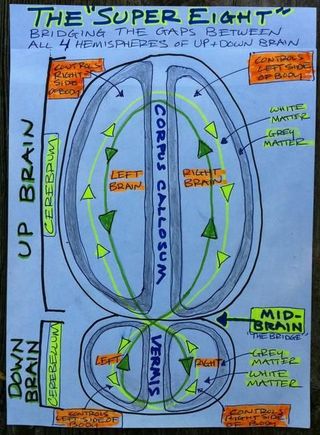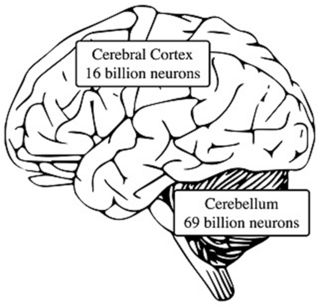Intelligence
5 Reasons the Cerebellum Is Key to Thriving in a Digital Age
For humans to thrive, the cerebellum must take center stage in the 21st century.
Posted May 14, 2016
In 1504, Leonardo da Vinci made wax castings of the human brain and coined the term cerebellum (Latin for “little brain”) to describe two small brain hemispheres that are neatly tucked under the relatively colossal hemispheres of the cerebrum (Latin for “brain").
The cerebellum is only 10% of brain volume but holds almost 80% of your brain's total neurons. Conversely, the cerebrum is 90% of brain volume but only holds approximately 20% of your brain's total neurons. Whatever the cerebellum is doing, it's doing a lot of it.
Historically, neuroscientists have considered the cerebellum to be the seat of non-thinking activities such as coordinating and fine-tuning muscle movements. However, in recent years, a wide range of studies have shown (for the first time) that the cerebellum plays a pivotal role in many of our cognitive, emotional, and creative processes. The cerebellum is also linked to autism spectrum disorders (ASD), post-traumatic stress disorder (PTSD), theory of mind, empathetic responses, and learning real-world social skills.
Unfortunately, living in a digital era has lead to excessive screen time and chronic sedentarism which is causing the cerebellum to atrophy. The future shock of modern life is disrupting the structure and functional connectivity of the cerebellum with the cerebral cortex which is causing our bodies and minds to short circuit. For human beings to continue to thrive in this millennium, the cerebellum must not be allowed to atrophy through sedentarism and excessive screen time in the 21st century.
5 Reasons the Cerebellum Is Key to Thriving in a Digital Age by Bergland
- The cerebellum is central to fluid intelligence and divergent thinking. The cerebellum will atrophy if you are chronically inactive and sit all day.
- Excessive screen time reduces cerebellum size, hands-on socialization, theory of mind, and implicit social skills.
- The cerebellum may be the seat of creativity, imagination, and innovation.
- Autism spectrum disorders, purkinje cells, and the cerebellum are intertwined.
- Aerobic exercise facilitates superfluidity (the highest tier of what Mihály Csíkszentmihályi describes as flow) by stimulating the synchronization and connectivity of all four brain hemispheres—this includes both hemispheres of the cerebrum and both hemispheres of the cerebellum.
The Cerebellum Has Been Underestimated and Misunderstood For Too Long
My father, Richard M. Bergland, was a neurosurgeon, neuroscientist, and author of The Fabric of Mind (Viking). My dad was obsessed with the cerebellum and passed this obsession on to me. I always root for the underdog. The cerebellum is both literally and figuratively the underdog when it comes to the "David and Goliath" public relations problem it has with the superstardom of the cerebrum. I often refer to the cerebrum as "Godzilla" and the cerebellum as "Mighty Mouse" based on the degree to which most experts and the general public underestimate the strength and importance of their cerebellum.

During the late-20th century, my father grew frustrated that so many of his peers in the medical establishment refused to acknowledge the full potential and importance of the cerebellum. Many labeled my dad a 'heretic' when he tried to advance his hypothesis that the cerebellum might play a role in cognitive processes. He would often say to me, "We don't know exactly what the cerebellum is doing, but whatever it's doing, it's doing a lot of it." When my father died in 2007, I made a vow to continue researching and writing about the cerebellum, in his honor... but also, because of my innate curiosity to solve the many riddles of our mysterious and powerful "little brain."
My fascination with the cerebellum has been a part of my DNA for as long as I can remember. As a young tennis player, my father would coach me by saying, “Chris, think about hammering and forging the muscle memory of your cerebellum with every stroke.” While I was writing the manuscript for The Athlete’s Way (St. Martin's Press) in 2005, my father and I spoke every day about neuroscience, sports, and cognitive function. Together, we created a novel split-brain model that seated 'conscious' and explicit learning and memory in the cerebrum and 'unconscious' implicit learning and memory in the cerebellum which we called "up brain-down brain."
Conclusions: Now Is the Time. We Must Put the Cerebellum in the Spotlight

This morning, I was thrilled to read a new groundbreaking article by Larry Vandervert, "The Prominent Role of the Cerebellum in the Learning, Origin, and Advancement of Culture," which appears in the journal Cerebellum & Ataxias. Vandervert sums up his hypothesis by saying, "There is now strong evidence that the learning, maintenance, and advancement of culture are accomplished primarily by the recently evolved cognitive functions of the cerebellum and not, as traditionally thought, by the cerebral cortex."
When it comes to having a better understanding of the cerebellum, Larry Vandervert has been a personal and professional inspiration to me over the years. He is one of the few thought leaders who has put the cerebellum in the spotlight. Vandervert continues to connect the dots of cutting-edge cerebellar research in new and convincing ways. (Cerebellar is the sister word to cerebral and means "relating to or located in the cerebellum".)
After reading Vandervert's article this morning, I had an "Aha!" moment. For the first time, I realized the paramount importance of maintaining the integrity of cerebellar structures and functional connectivity with the cerebral cortex as we advance into a more sedentary digital age. Currently, our culture is hyperfocused on crystallized intelligence and standardized achievement tests which could ultimately cause the cerebellum to atrophy. I believe it's critical that our society make strides to reverse this trend. (Thank you for inspiring this epiphany, Larry!)
Hopefully, the latest scientific findings on the cerebellum will serve as a call to action for all of us to regularly engage the cerebellum more through art, dance, music, aerobic activity, face-to-face social interactions, etc. throughout our lifespan. Stay tuned for more on this exciting topic!
To read more about the cerebellum, check out my previous Psychology Today blog posts:
- "The Cerebellum Deeply Influences Our Thoughts and Emotions"
- "The Cerebellum May Be the Seat of Creativity"
- "How Are Digital Devices Changing the Way We Think?"
- "Eureka! Deconstructing the Brain Mechanics of Aha! Moments"
- "Cerebellum Damage May Be the Root of PTSD in Combat Veterans"
- "More Research Links Autism and the Cerebellum"
- "Too Much Crystallized Thinking Lowers Fluid Intelligence"
- "How Do Motor Regions of the Brain Drive Fluid Intelligence?"
- "Aha! Aerobic Exercise Facilitates the Free Flow of Thought"
- "Superfluidity: Decoding the Enigma of Cognitive Flexibility"
© 2016 Christopher Bergland. All rights reserved.
Follow me on Twitter @ckbergland for updates on The Athlete’s Way blog posts.
The Athlete’s Way ® is a registered trademark of Christopher Bergland




